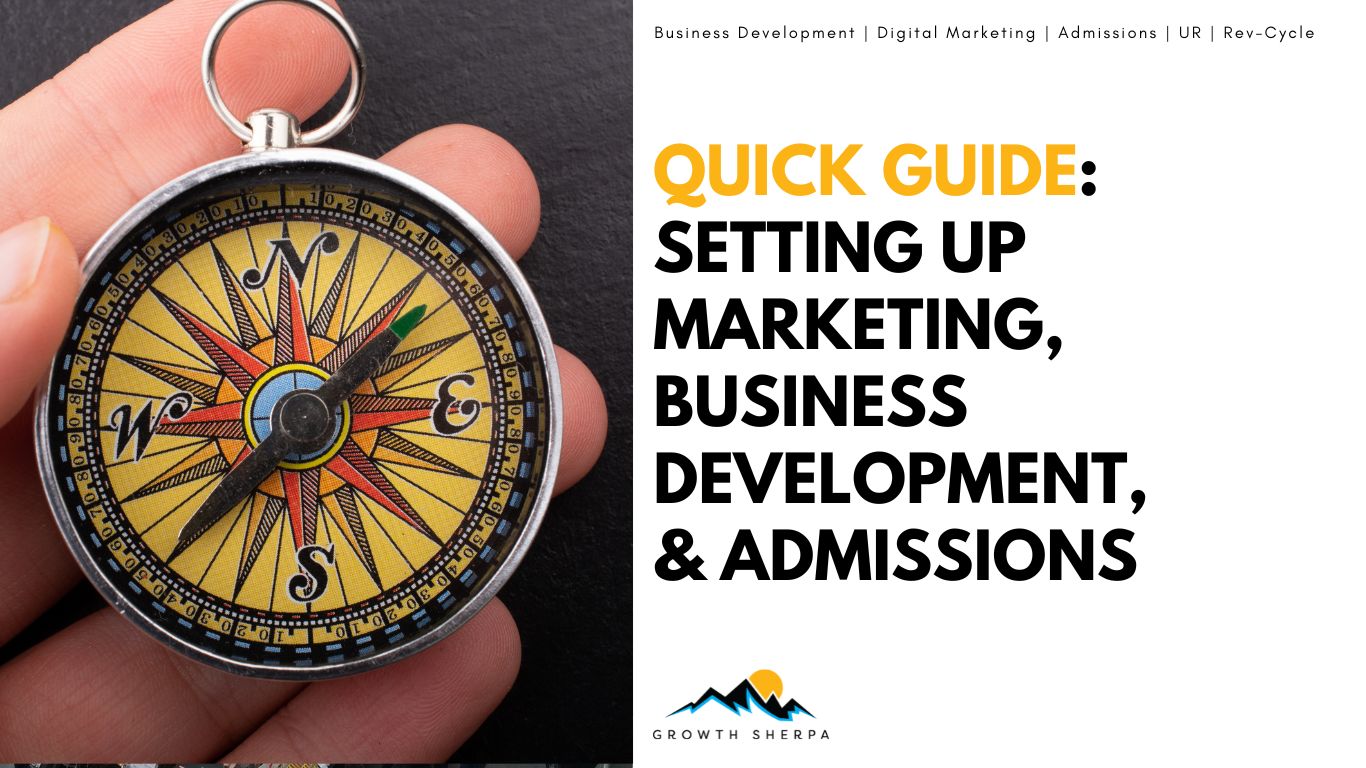Launching a new addiction treatment facility is a complex undertaking that requires a strong foundation in marketing, business development (BD), and admissions to ensure long-term success. These three pillars must be seamlessly integrated to attract and convert clients, build relationships with referral sources, and maintain operational efficiency. This guide provides a step-by-step approach to setting up marketing, BD, and admissions effectively.
1. Launch Website and Social Media 2-3 Months in Advance
A strong online presence is critical for SEO, audience growth, and credibility. Your website should be fully optimized, mobile-friendly, and include engaging content that speaks to your target audience. It should also have clear calls to action (CTAs) for admissions inquiries. Social media accounts should be set up and actively posting content at least 2-3 months before opening. This will help generate interest, establish thought leadership, and build trust with potential clients and their families. Paid social media campaigns can further amplify your reach, targeting those seeking treatment services.
2. Set Up Dynamic Call Tracking and CRM for Admissions & BD
Implementing dynamic call tracking allows you to measure marketing performance and understand which sources drive calls to your admissions team. This data helps refine marketing efforts and optimize lead generation. A customer relationship management (CRM) system is essential for tracking inquiries, managing follow-ups, and optimizing conversions. Your CRM should integrate seamlessly with your call tracking system to provide a holistic view of your admissions and BD efforts. Ensure staff is trained to use the system effectively.
3. Train BD & Admissions Teams on Systems and Processes
Technology is only as effective as the people using it. Comprehensive training on the CRM, call tracking software, and admissions process ensures that staff can efficiently handle inquiries, follow up on leads, and provide an excellent client experience. Role-playing exercises, call scripts, and scenario-based training can prepare teams to handle objections and difficult conversations with empathy and professionalism. Consistency in messaging and approach across all interactions is key to building trust.
4. Set Up Google Business Profile (GBP) and Other Directory Listings
A fully optimized Google Business Profile (GBP) enhances local search visibility and provides essential information such as contact details, directions, and reviews. Ensure your GBP includes accurate business name, address, and phone number (NAP), high-quality images of your facility, detailed service descriptions, regular posts and updates, and solicited client reviews to build credibility. Beyond Google, claim and optimize listings on relevant directories such as Bing Places, Psychology Today, and Rehab.com.
5. Confirm Cloud-Based Phone System is Operational
A reliable phone system is the backbone of your admissions process. Cloud-based phone systems offer flexibility, call recording, and routing features that enhance efficiency. Ensure that calls can be forwarded to admissions representatives as needed, voicemail messages are transcribed and delivered promptly, call data integrates with CRM and call tracking systems, and the system is tested thoroughly before launch.
6. Integrate Alumni Brand Into the Treatment Experience
Your alumni program should be woven into the fabric of your treatment experience from day one. This means introducing alumni support services during treatment, creating opportunities for peer mentorship, encouraging long-term engagement through events, online communities, and newsletters, and showcasing alumni success stories in marketing materials. A strong alumni network enhances retention, generates referrals, and reinforces the long-term value of your facility’s programs.
7. Ensure Facility Branding and Signage Are Consistent
Cohesive branding strengthens recognition and trust. Your facility’s signage, marketing materials, and digital presence should all reflect a unified brand identity. This includes a professionally designed logo and brand color scheme, consistent typography and imagery across all materials, branded interior and exterior signage that enhances the client experience, and digital assets that align with printed collateral.
8. Create Accessible Print Materials for BD & Operations
Business development teams need high-quality, easily accessible print materials for outreach efforts. These materials should be available in both physical and digital formats via an on-demand print portal. Essential materials include brochures outlining treatment services, business cards for key staff members, flyers detailing specialty programs, and physician referral forms and partnership agreements. Having a print-on-demand system ensures that materials are always up to date and readily available.
9. Develop a Comprehensive Admissions Protocol
A seamless admissions process is critical for converting inquiries into clients. This protocol should cover initial inquiry handling and pre-screening questions, insurance verification and financial discussions, clinical assessments and pre-admission paperwork, and coordination with family members and referring professionals. Streamlining these steps reduces friction for clients and increases conversion rates.
10. Establish Key Performance Indicators (KPIs) and Reporting Structures
Regular performance tracking ensures continuous improvement. Key metrics to monitor include website traffic and conversion rates, call tracking and inquiry-to-admission conversion rates, CRM data on follow-ups and pipeline progression, and business development outreach efforts and referral source engagement. Setting up dashboards and automated reports helps leadership make data-driven decisions and optimize efforts in real time.
11. Develop Community Partnerships and Referral Networks
Building relationships with hospitals, mental health professionals, community organizations, and other referral sources strengthens your facility’s credibility and client pipeline. Strategies include hosting informational meetings and facility tours, participating in local health fairs and industry conferences, offering continuing education events for professionals, and establishing reciprocal referral agreements with complementary providers. A well-developed referral network provides a steady stream of potential clients while positioning your facility as a trusted resource.
12. Implement a Content Marketing and Outreach Strategy
Content marketing is essential for education, engagement, and SEO. A strong content plan should include regular blog posts addressing addiction treatment topics, email campaigns to nurture leads and referral relationships, video testimonials and success stories, and social media engagement through live Q&As and behind-the-scenes content. A mix of organic and paid content ensures a steady flow of traffic and inquiries.
13. Secure Compliance and Accreditation Marketing Approvals
Marketing in the addiction treatment space comes with regulatory considerations. Ensure all marketing materials comply with HIPAA regulations, Truth in Advertising standards, and accreditation requirements from organizations like The Joint Commission or CARF. Having legal and compliance teams review materials before distribution prevents potential legal and reputational risks.
14. Plan and Execute a Grand Opening Event
A grand opening event can generate buzz and establish community presence. Consider including facility tours for professionals and the public, guest speakers from the addiction treatment and recovery community, live demonstrations of key treatment modalities, and media coverage and social media live streaming. A well-executed launch event builds awareness, credibility, and excitement around your facility.
Building a New Facility
Setting up marketing, business development, and admissions for a new addiction treatment facility requires a strategic, integrated approach. By establishing a strong digital presence early, implementing tracking and CRM systems, training teams, ensuring branding consistency, and building referral networks, you set the foundation for long-term success. Investing in these key areas from the outset will maximize admissions, streamline operations, and position your facility as a leader in the industry.


